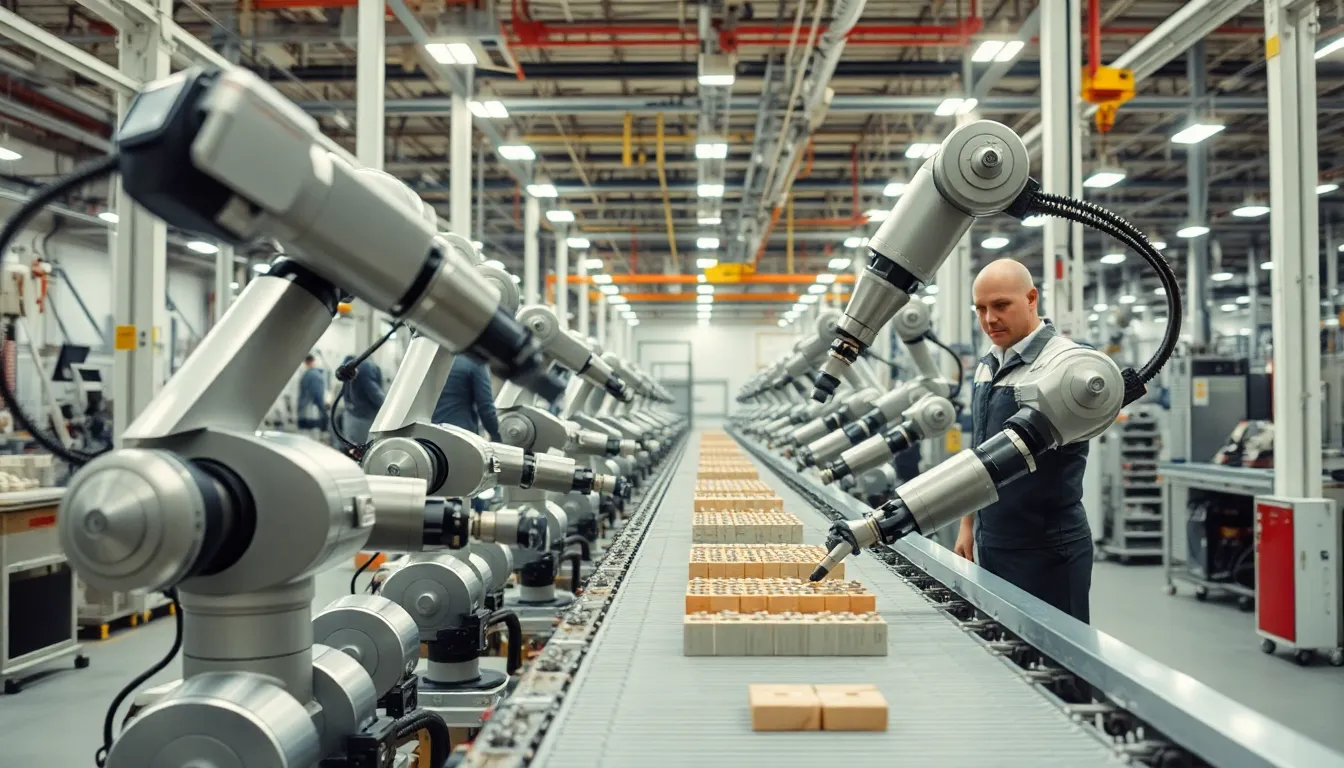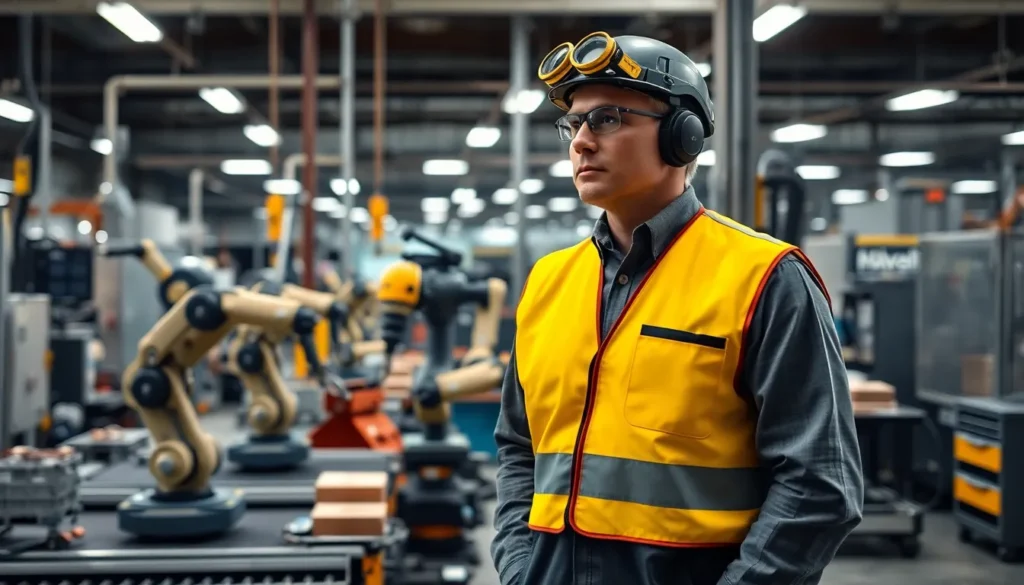In a world where machines are taking over everything from our homes to our workplaces, the manufacturing sector is no exception. Robots have become the unsung heroes of production lines, tirelessly assembling products while humans enjoy their coffee breaks. Who wouldn’t want a tireless colleague that doesn’t complain about the temperature or ask for a raise?
But it’s not just about saving labor costs or increasing efficiency; the integration of robots in manufacturing is revolutionizing the industry. These mechanical marvels are not only boosting productivity but also enhancing precision and safety. As companies embrace this technological evolution, they’re discovering that robots can be just as dependable as that one coworker who always brings donuts—only without the crumbs. So let’s dive into the fascinating world of robots in manufacturing and explore how they’re reshaping the future of production.
Table of Contents
ToggleOverview of Robots in Manufacturing
Robots are transforming the manufacturing landscape, playing a crucial role in enhancing productivity, efficiency, and safety. As technology advances, they emerge as essential partners in reshaping production processes.
Definition and Purpose
A robot in manufacturing typically refers to an automated machine designed to perform specific tasks. These machines streamline operations by executing repetitive tasks with high precision. They assist human workers by taking on mundane labor, allowing employees to focus on more complex activities. Robots also improve consistency in production, reducing the margin for error. Ultimately, their purpose revolves around increasing output while maintaining quality standards.
Types of Robots Used
Several types of robots contribute to manufacturing efficiency. Articulated robots are versatile, featuring rotating joints that enable complex movements. SCARA robots are great for pick-and-place tasks, excelling in horizontal movement. Collaborative robots, or cobots, work alongside humans, enhancing safety and productivity in shared environments. Also, gantry robots utilize a movable arm to transport materials across a defined area. Each type serves a specific function, ensuring optimized operations within the manufacturing process.
Advantages of Robots in Manufacturing

Robots in manufacturing offer significant advantages that transform production processes and overall business operations. These advantages include increased efficiency and cost reduction.
Increased Efficiency
Robots enhance manufacturing efficiency through speed and precision. Automated systems complete repetitive tasks with minimal downtime, leading to higher output rates. Adaptability allows robots to switch between tasks with ease, accommodating varying production demands. Real-time data analysis optimizes workflows, ensuring that machines operate at peak performance levels. Human workers remain free to focus on complex problems while robots handle mundane tasks, thereby accelerating overall productivity.
Cost Reduction
Cost reduction emerges as a crucial benefit when integrating robots into manufacturing. Labor costs decrease due to lower reliance on human workers for repetitive tasks. Consistent performance of robots minimizes errors and waste, leading to enhanced quality control and reduced rework expenses. Furthermore, robots often operate with less energy than manual processes, cutting utility costs over time. Overall, businesses experience a significant return on investment as robots streamline processes and drive long-term savings.
Challenges in Implementing Robots
Implementing robots in manufacturing brings numerous challenges that require careful consideration.
Initial Investment
High upfront costs often deter businesses from adopting robotic systems. The initial investment encompasses purchasing robots, installation, and training for personnel. Many companies hesitate due to financial constraints, impacting their decision-making process. Long-term benefits may outweigh these costs; however, securing funding poses additional challenges. Businesses frequently analyze return on investment (ROI) before committing to such technologies. In 2022, manufacturers reported an average ROI period of 1.5 to 3 years for robotic investments. Thorough planning and budget allocation can mitigate financial pressures while promoting automation’s advantages.
Technical Issues
Technical issues present another significant hurdle during robot implementation. Compatibility with existing systems often becomes a primary concern. Robots may require specific software integrations or hardware adjustments, complicating integration efforts. Unforeseen malfunctions can disrupt production schedules, leading to downtime. Ensuring adequate maintenance becomes crucial to prolonging the lifespan of robotic systems. Training workers on new technologies also demands time and resources, making it essential for companies to prioritize skill development. In summary, addressing technical challenges proactively enhances the potential for successful robot integration.
Future Trends in Robots in Manufacturing
Robots in manufacturing continue evolving, driven by technological advancements and the need for efficiency. The focus now shifts toward integrating more complex systems into production.
Advancements in AI and Automation
AI integration enhances robotic capabilities, allowing machines to learn and adapt. This shift promotes autonomous decision-making, enabling robots to optimize tasks in real-time. Increased processing power fosters advanced computer vision, enabling robots to identify defects with high accuracy. Machine learning algorithms contribute to predictive maintenance, reducing unplanned downtime by anticipating failures before they occur. As a result, manufacturers experience significant productivity boosts and reduced operational costs.
Integration with IoT
Linking robots with IoT devices transforms manufacturing processes. Connectivity provides real-time data exchange between machines, enabling efficient resource management. Sensors monitor equipment performance and environmental conditions, enhancing overall system visibility. This integration allows for smarter production lines, where robots communicate and collaborate seamlessly. By leveraging data insights, organizations can streamline workflows and quickly address production challenges, reinforcing the competitive advantage in the market.
The integration of robots in manufacturing is reshaping the industry landscape. As these machines continue to evolve they bring unmatched efficiency precision and cost savings. Businesses that embrace robotic technology position themselves for a competitive edge in a rapidly changing market.
While challenges like high initial costs and technical compatibility exist proactive planning and investment in training can mitigate these issues. The future promises even more advancements with AI and IoT enhancing robotic capabilities.
By leveraging these innovations manufacturers can optimize workflows improve safety and ultimately drive growth. The partnership between humans and robots is set to redefine production standards and elevate the manufacturing sector to new heights.





